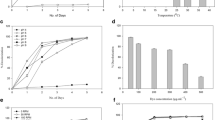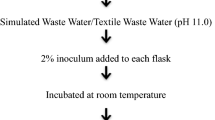Abstract
In this present study, bacteria were isolated from wastewater and polluted soil collected from two cottage textile factories in Ibadan. These bacteria isolates were used for the biotreatment of textile mill effluent. The physicochemical parameters of the textile mill effluent before treatment were carried out and percentage decolourisation of the effluent was analysed using ultraviolet-visible spectroscopy (UV-vis technique). The degradation products of the textile mill effluent characterised by Fourier transform infrared spectroscopy (FTIR). The pH values of the effluent were within the permissible limit of Federal Environmental Protection Agency (FEPA) and National Environmental Standards and Regulations Enforcement Agency (NESREA), while temperature and electric conductivity of the effluents were below the permissible limit of FEPA and NESREA. The BOD, COD, TSS, TDS and chloride of the textile mill effluent from the two cottage textile factories were above the permissible limits of FEPA and NESREA. Twelve bacteria isolates were screened, effective in decolourising commercial dyes and used to decolourise the textile mill effluent. The bacteria isolates were characterised and identified as Bacillus sp., Micrococcus sp., Erwinia sp., Acinetobacter sp. and Nocardia sp. The decolourisation of textile effluent was observed through the changes of spectra of UV-visible spectrophotometer. The following bacteria revealed different percentage proportion of decolouration profile:- Bacillus sp., had the highest percentage decolourisation of 57.7%, whereas Micrococcus sp. and Acinetobacter sp. had percentage decolourisation of 32.8 and 26.3%, respectively. The degradation profile of textile effluent was revealed through FTIR spectral analysis. The changes in the position of major peaks revealed from the textile effluent through FTIR spectral analysis, appearances of new peaks and the disappearances of existing peaks signify the degradation of the wastewater. Thus, some native microorganisms from the textile effluent could be enhanced to effectively degrade effluent from such environments.

Similar content being viewed by others
References
Agarry, S. E., & Ajani, A. O. (2011). Evaluation of microbial systems for biotreatment of textile waste effluents in Nigeria: Biodecolourisation and biodegradation of textile dye. Journal of applied science and. Environmental Management, 15(1), 79–86.
APHA-AWWA (1985). Standard methods for the examination of waste and wastewater, 16th ed. American Public Health Association, Washinghton, DC.
Carneiro, P. A., Osugi, M. E., Sene, J. J., Anderson, M. A., & Zanoni, M. V. B. (2003). Evaluation of color removal and degradation of a reactive textile azo dye on nanoporous TiO thin-film electrodes. Electrochimica Acta, 49(22), 3807–3820.
Chequer, F.M., de Oliveira, G.R.A., Ferraz, E.R., Cardoso, J.C., Zanoni, M.V., de Oliveira, D.P. (2013). Textile dyes: dyeing process and environmental impact.
Coates, J. (2000). Interpretation of infrared spectra, a practical approach. In R. A. Meyers (Ed.), Encyclopedia of analytical chemistry, John Wiley and Sons ltd (pp. 10815–10837). United Kingdom: Chichester.
Deepali, & Gangwar, K. K. (2010). Metals concentration in textile and tannery effluents, associated soils and ground water. New York Science Journal, 3(4), 82–89.
Ebency, C. I. L., Rajan, S., Murugesan, A. G., Rajesh, R., & Elayarajah, B. (2013). Biodegradation of textile azo dyes and its bioremediation potential using seed germination efficiency. International journal of current microbiology and applied. Science, 2(10), 496–505.
Elisangela, F., Andrea, Z., Fabio, D. G., de Menezes, R., Regina, D. L., & Artur, C. P. (2009). Biodegradation of textile azo dyes by a facultative Staphylococcus arlettae strain VN-11 using a sequential microaerophilic/aerobic process. International Biodeterioration and Biodegradation, 63, 280–288, 3. https://doi.org/10.1016/j.ibiod.2008.10.003.
Elsheikh, M. A., & Al-Hemaidi, W. K. (2012). Approach in choosing suitable technology for industrial wastewater treatment. Journal of civil and. Environmental Engineering, 2(5), 123.
Environmental Technology Best Practice Programme (ETBPP) (1997). Water and chemical use in the textile dyeing and finishing industry.
Ghaly, A. E., Ananthashankar, R., Alhattab, M., & Ramakrishnan, V. V. (2014). Production, characterization and treatment of textile effluents: a critical review. Journal of Chemical Engineering and Process Technology, 5, 182.
Holt, G.J., Krieg, N.R., Sneath, P.H., Staley, J.T., William, S.T. (2000). Bergey’s manual of determinative bacteriology (9th Edition). Lippincott Williams & Wilkins, 530 Walnut St, Philadelphia, PA 19106 USA.
Kashim, I. B., Adiji, B. E., & Oladumiye, E. B. (2012). The impact of cottage textile industries on students’of textile designs in tertiary institutions in South Western Nigeria. Education Research Journal, 2(3), 75–86.
Khan, S., & Mathur, N. (2013). Microbial flora of textile effluents areas of Western Rajasthan. International Journal of Plant, Animal and Environmental Sciences, 3(3), 127–129.
Khehra, M. S., Saini, H. S., Sharma, D. K., Chadha, B. S., & Chimni, S. S. (2006). Biodegradation of azo dye C.I acid red 88 by an anoxic-aerobic sequential bioreactor. Dyes and Pigments, 70, 1–7, 1. https://doi.org/10.1016/j.dyepig.2004.12.021.
Lambert, J. B., Shurvell, H. F., & Cooks, R. G. (1987). Introduction to organic spectroscopy. New York: Macmillan Publication.
Mahmood, R., Sharif, F., Ali, S., & Hayyat, M. U. (2013). Bioremediation of textile effluent by indigenous bacterial consortia and its effects on Zea mays L. CV C1415. The Journal of Animal and Plant Sciences, 23(4), 1193–1199.
Marimuthu, T., Rajendran, S., & Manivannan, M. (2013). Water pollution in Karur district—a critical review. Asian Journal of Science and Technology, 4(7), 42–44.
Ogunjobi, A. A., Oyinloye, I. A., & Sanuth, H. A. (2012). Bioremediation of effluent from local textile industry using Bacillus licheniformis. New York Science Journal, 5, 12.
Ogunlaja, O. O., & Ogunlaja, A. (2009). Evaluating the efficiency of a textile wastewater treatment plant located in Oshodi, Lagos. African Journal of Pure and Applied Chemistry, 3(9), 189–196.
Puvaneswari, N., Muthukrishnan, J., & Gunasekaran, P. (2006). Toxicity assessment and microbial degradation of azo dyes. Indian Journal of Experimental Biology, 44, 618–626 8.
Savin, I., & Butnaru, R. (2008). Wastewater characteristics in textile finishing mills. Environmental Engineering and Management Journal, 7(6), 859–864.
Shah, M. P. (2014). Biodegradation of azo dyes by three isolated bacterial strains: an environmental biomedical approach. Journal of Microbial and Biochemical Technology, S3, 007. https://doi.org/10.4172/1948-5948.S3-007.
Wang, Z., Xue, M., Huang, K., Liu, Z. (2011). Textile dyeing wastewater treatment, advances in treating textile effluent.
World Health Organization. (2010). Some aromatic amines, organic dyes, and related exposures. International Agency for Research on Cancer (IARC) Monographs on the Evaluation of Carcinogenic Risks to Humans, 99, 55–66.
Yusuff, R. O., & Sonibare, J. A. (2004). Characterization of textile industries’ effluents in Kaduna, Nigeria and pollution implications. The International Journal, 6(3), 212–221.
Acknowledgements
The authors are grateful to the University of Ibadan, Nigeria for providing the necessary materials and enabling environment for the research to be carried out.
Author information
Authors and Affiliations
Corresponding author
Ethics declarations
Conflict of interest
The authors declare that they have no conflict of interest.
Electronic supplementary material
ESM 1
(DOCX 2780 kb)
Rights and permissions
About this article
Cite this article
Okareh, O.T., Ademodi, T.F. & Igbinosa, E.O. Biotreatment of effluent from ‘Adire’ textile factories in Ibadan, Nigeria. Environ Monit Assess 189, 629 (2017). https://doi.org/10.1007/s10661-017-6357-9
Received:
Accepted:
Published:
DOI: https://doi.org/10.1007/s10661-017-6357-9




